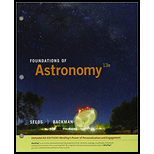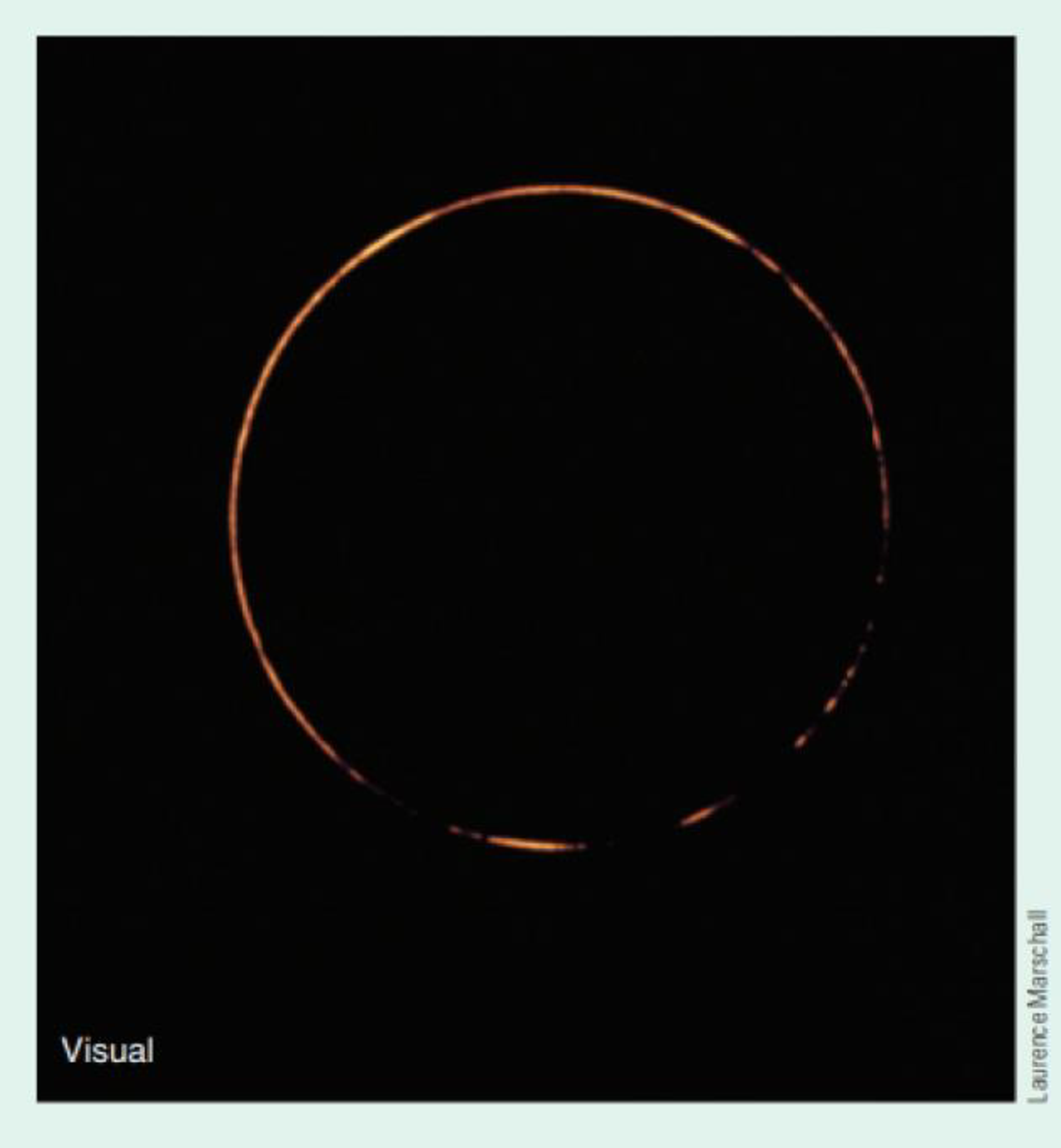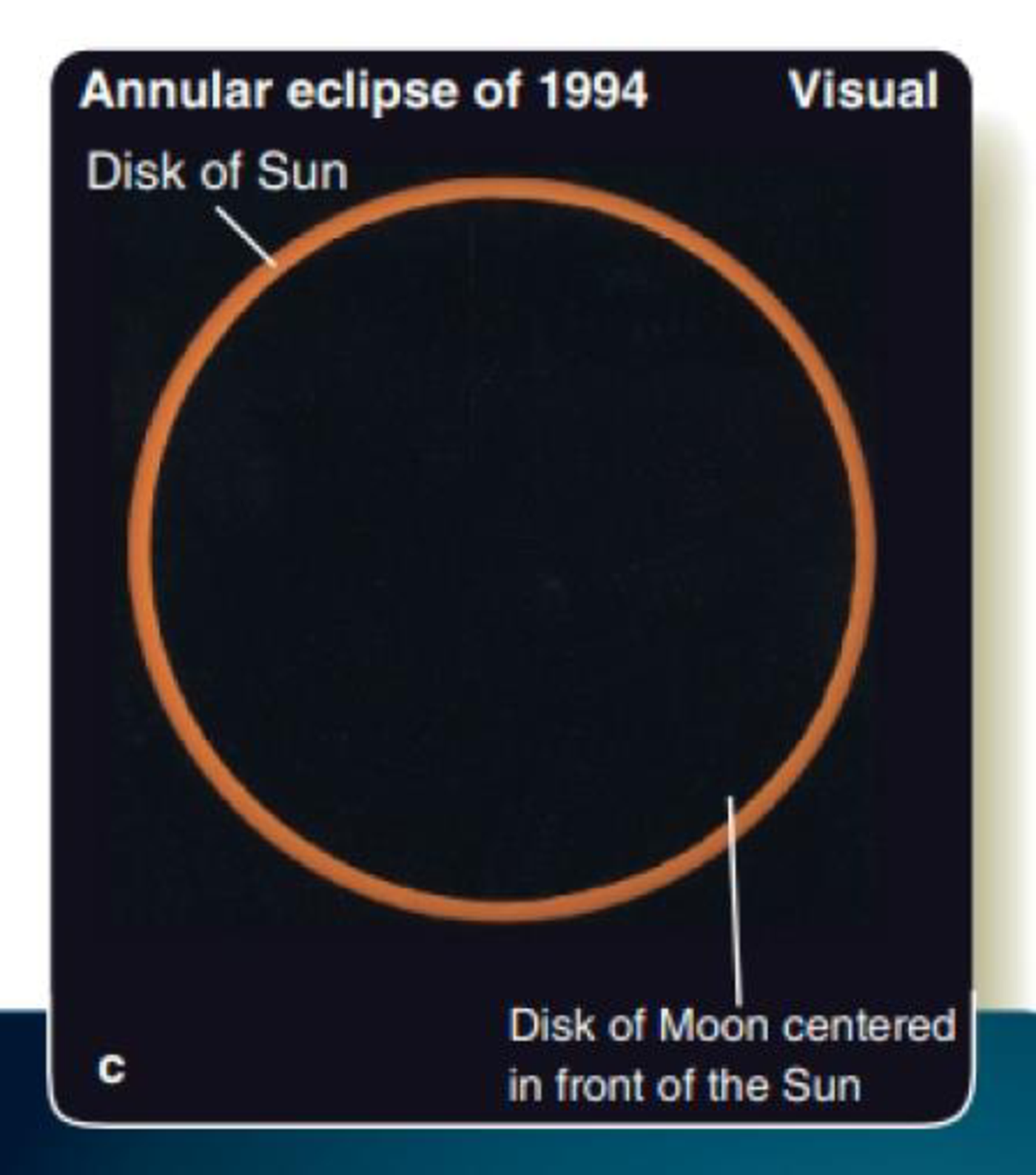
Bundle: Foundations of Astronomy, Enhanced, Loose-Leaf Version, 13th + MindTap Astronomy, 2 terms (12 months) Printed Access Card
13th Edition
ISBN: 9781337214353
Author: Seeds, Michael A., Backman, Dana
Publisher: Cengage Learning
expand_more
expand_more
format_list_bulleted
Concept explainers
Textbook Question
Chapter 3, Problem 12LTL
This photo shows the annular eclipse of May 30, 1984. How is it different from the annular eclipse shown in Figure 3-10c?


Figure 3·10 (a) Because the angular diameter of the Moon and the Sun vary slightly, the disk of the Moon is sometimes too small to cover the disk of the Sun. (b) That means the umbra of the Moon does not reach Earth, and the eclipse is annular, meaning a ring ("annulus") of the Sun's disk can be seen around the Moon. (c) In this photograph of an annular eclipse in 1994, the dark disk of the Moon is almost exactly centered on the bright disk of the Sun.
Expert Solution & Answer
Trending nowThis is a popular solution!

Students have asked these similar questions
You are standing a distance x = 1.75 m away from this mirror. The object you are looking at is y = 0.29 m from the mirror. The angle of incidence is θ = 30°. What is the exact distance from you to the image?
For each of the actions depicted below, a magnet and/or metal loop moves with velocity v→ (v→ is constant and has the same magnitude in all parts). Determine whether a current is induced in the metal loop. If so, indicate the direction of the current in the loop, either clockwise or counterclockwise when seen from the right of the loop. The axis of the magnet is lined up with the center of the loop. For the action depicted in (Figure 5), indicate the direction of the induced current in the loop (clockwise, counterclockwise or zero, when seen from the right of the loop). I know that the current is clockwise, I just dont understand why. Please fully explain why it's clockwise, Thank you
A planar double pendulum consists of two point masses \[m_1 = 1.00~\mathrm{kg}, \qquad m_2 = 1.00~\mathrm{kg}\]connected by massless, rigid rods of lengths \[L_1 = 1.00~\mathrm{m}, \qquad L_2 = 1.20~\mathrm{m}.\]The upper rod is hinged to a fixed pivot; gravity acts vertically downward with\[g = 9.81~\mathrm{m\,s^{-2}}.\]Define the generalized coordinates \(\theta_1,\theta_2\) as the angles each rod makes with thedownward vertical (positive anticlockwise, measured in radians unless stated otherwise).At \(t=0\) the system is released from rest with \[\theta_1(0)=120^{\circ}, \qquad\theta_2(0)=-10^{\circ}, \qquad\dot{\theta}_1(0)=\dot{\theta}_2(0)=0 .\]Using the exact nonlinear equations of motion (no small-angle or planar-pendulumapproximations) and assuming the rods never stretch or slip, determine the angle\(\theta_2\) at the instant\[t = 10.0~\mathrm{s}.\]Give the result in degrees, in the interval \((-180^{\circ},180^{\circ}]\).
Chapter 3 Solutions
Bundle: Foundations of Astronomy, Enhanced, Loose-Leaf Version, 13th + MindTap Astronomy, 2 terms (12 months) Printed Access Card
Ch. 3 - Why are most of the constellations that were...Ch. 3 - Prob. 2RQCh. 3 - Which is the asterism and which is the...Ch. 3 - Prob. 4RQCh. 3 - Prob. 5RQCh. 3 - What does the word apparent mean in apparent...Ch. 3 - Prob. 7RQCh. 3 - Prob. 8RQCh. 3 - Prob. 9RQCh. 3 - Could a solar powered spacecraft generate any...
Ch. 3 - If a lunar eclipse occurred at midnight, where in...Ch. 3 - If Earth had no atmosphere, what color would the...Ch. 3 - If the Moon orbited Earth from North Pole to South...Ch. 3 - Why do solar eclipses happen only at new moon? Why...Ch. 3 - Why isnt the corona visible during partial or...Ch. 3 - Which has the larger angular diameter in the...Ch. 3 - What is the angular diameter of the Moon in the...Ch. 3 - Why cant the Moon be eclipsed when it is halfway...Ch. 3 - Why are solar eclipses separated by one Saros...Ch. 3 - How could Thales of Miletus have predicted the...Ch. 3 - Will an eclipse occur in February 2025? In July...Ch. 3 - How do we know? Some people think science is like...Ch. 3 - Can you see the dark side of the Moon from Earth?
Ch. 3 - What would the correct response be to someone who...Ch. 3 - Prob. 3DQCh. 3 - Prob. 4DQCh. 3 - Prob. 5DQCh. 3 - Pretend the Moons orbit around Earth is a perfect...Ch. 3 - Identify the phases of the Moon if on March 20 the...Ch. 3 - Identify the phases of the Moon if at sunset in...Ch. 3 - What fraction of the Moons surface area is the far...Ch. 3 - About how many days must elapse between...Ch. 3 - Tonight you see a waning crescent in the night...Ch. 3 - If on March 1 the Moon is full and is near Famous...Ch. 3 - How many times larger than the Moon is the...Ch. 3 - Use the small-angle formula to calculate the...Ch. 3 - Prob. 10PCh. 3 - At perigee, the Moon is closer than average by...Ch. 3 - Examine the list of upcoming lunar eclipses in...Ch. 3 - Prob. 13PCh. 3 - If a solar eclipse occurs on October 3: (a) Why...Ch. 3 - A total eclipse of the Sun was visible from Canada...Ch. 3 - Prob. 16PCh. 3 - When will the eclipse seasons occur during the...Ch. 3 - Examine Figure 3-16. List the letter S for each...Ch. 3 - Look at the Chapter 2 Concept Art: The Sky Around...Ch. 3 - To take the photos that are combined on the...Ch. 3 - Look at the Chapter 3 Concept Art: The Phases of...Ch. 3 - Look at the Chapter 3 Concept Art: The Phases of...Ch. 3 - Use the photos in Figure 3-1 as evidence to show...Ch. 3 - Prob. 6LTLCh. 3 - Prob. 7LTLCh. 3 - Prob. 8LTLCh. 3 - Prob. 9LTLCh. 3 - What evidence of the Saros cycle can you see in...Ch. 3 - The accompanying cartoon shows a crescent moon....Ch. 3 - This photo shows the annular eclipse of May 30,...
Knowledge Booster
Learn more about
Need a deep-dive on the concept behind this application? Look no further. Learn more about this topic, physics and related others by exploring similar questions and additional content below.Similar questions
- What are the expected readings of the ammeter and voltmeter for the circuit in the figure below? (R = 5.60 Ω, ΔV = 6.30 V) ammeter I =arrow_forwardsimple diagram to illustrate the setup for each law- coulombs law and biot savart lawarrow_forwardA circular coil with 100 turns and a radius of 0.05 m is placed in a magnetic field that changes at auniform rate from 0.2 T to 0.8 T in 0.1 seconds. The plane of the coil is perpendicular to the field.• Calculate the induced electric field in the coil.• Calculate the current density in the coil given its conductivity σ.arrow_forward
- An L-C circuit has an inductance of 0.410 H and a capacitance of 0.250 nF . During the current oscillations, the maximum current in the inductor is 1.80 A . What is the maximum energy Emax stored in the capacitor at any time during the current oscillations? How many times per second does the capacitor contain the amount of energy found in part A? Please show all steps.arrow_forwardA long, straight wire carries a current of 10 A along what we’ll define to the be x-axis. A square loopin the x-y plane with side length 0.1 m is placed near the wire such that its closest side is parallel tothe wire and 0.05 m away.• Calculate the magnetic flux through the loop using Ampere’s law.arrow_forwardDescribe the motion of a charged particle entering a uniform magnetic field at an angle to the fieldlines. Include a diagram showing the velocity vector, magnetic field lines, and the path of the particle.arrow_forward
- Discuss the differences between the Biot-Savart law and Coulomb’s law in terms of their applicationsand the physical quantities they describe.arrow_forwardExplain why Ampere’s law can be used to find the magnetic field inside a solenoid but not outside.arrow_forward3. An Atwood machine consists of two masses, mA and m B, which are connected by an inelastic cord of negligible mass that passes over a pulley. If the pulley has radius RO and moment of inertia I about its axle, determine the acceleration of the masses mA and m B, and compare to the situation where the moment of inertia of the pulley is ignored. Ignore friction at the axle O. Use angular momentum and torque in this solutionarrow_forward
- A 0.850-m-long metal bar is pulled to the right at a steady 5.0 m/s perpendicular to a uniform, 0.650-T magnetic field. The bar rides on parallel metal rails connected through a 25-Ω, resistor (Figure 1), so the apparatus makes a complete circuit. Ignore the resistance of the bar and the rails. Please explain how to find the direction of the induced current.arrow_forwardFor each of the actions depicted, determine the direction (right, left, or zero) of the current induced to flow through the resistor in the circuit containing the secondary coil. The coils are wrapped around a plastic core. Immediately after the switch is closed, as shown in the figure, (Figure 1) in which direction does the current flow through the resistor? If the switch is then opened, as shown in the figure, in which direction does the current flow through the resistor? I have the answers to the question, but would like to understand the logic behind the answers. Please show steps.arrow_forwardWhen violet light of wavelength 415 nm falls on a single slit, it creates a central diffraction peak that is 8.60 cm wide on a screen that is 2.80 m away. Part A How wide is the slit? ΟΙ ΑΣΦ ? D= 2.7.10-8 Submit Previous Answers Request Answer × Incorrect; Try Again; 8 attempts remaining marrow_forward
arrow_back_ios
SEE MORE QUESTIONS
arrow_forward_ios
Recommended textbooks for you
 Foundations of Astronomy (MindTap Course List)PhysicsISBN:9781337399920Author:Michael A. Seeds, Dana BackmanPublisher:Cengage Learning
Foundations of Astronomy (MindTap Course List)PhysicsISBN:9781337399920Author:Michael A. Seeds, Dana BackmanPublisher:Cengage Learning Stars and Galaxies (MindTap Course List)PhysicsISBN:9781337399944Author:Michael A. SeedsPublisher:Cengage Learning
Stars and Galaxies (MindTap Course List)PhysicsISBN:9781337399944Author:Michael A. SeedsPublisher:Cengage Learning

 Stars and GalaxiesPhysicsISBN:9781305120785Author:Michael A. Seeds, Dana BackmanPublisher:Cengage Learning
Stars and GalaxiesPhysicsISBN:9781305120785Author:Michael A. Seeds, Dana BackmanPublisher:Cengage Learning AstronomyPhysicsISBN:9781938168284Author:Andrew Fraknoi; David Morrison; Sidney C. WolffPublisher:OpenStax
AstronomyPhysicsISBN:9781938168284Author:Andrew Fraknoi; David Morrison; Sidney C. WolffPublisher:OpenStax

Foundations of Astronomy (MindTap Course List)
Physics
ISBN:9781337399920
Author:Michael A. Seeds, Dana Backman
Publisher:Cengage Learning

Stars and Galaxies (MindTap Course List)
Physics
ISBN:9781337399944
Author:Michael A. Seeds
Publisher:Cengage Learning



Stars and Galaxies
Physics
ISBN:9781305120785
Author:Michael A. Seeds, Dana Backman
Publisher:Cengage Learning

Astronomy
Physics
ISBN:9781938168284
Author:Andrew Fraknoi; David Morrison; Sidney C. Wolff
Publisher:OpenStax
General Relativity: The Curvature of Spacetime; Author: Professor Dave Explains;https://www.youtube.com/watch?v=R7V3koyL7Mc;License: Standard YouTube License, CC-BY